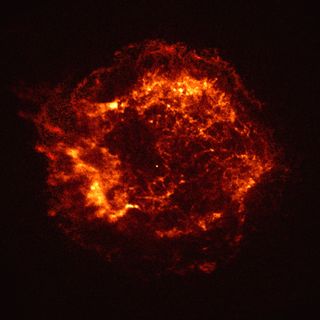NASA’s newly launched X-ray hunting probe has taken its first science picture and – wow – it’s amazing.
The Imaging X-ray Polarimetry Explorer (IXPE) probe launched on December 9, 2021, on a mission to monitor objects such as black holes and neutron stars in X-ray light, shedding much-anticipated light on the inner workings of the universe. The probe spent its first month in space checking out its various systems in preparation for its first images, and now the IXPE team has released its first scientific image.
The image shows Cassiopeia A, the remnant of a star that exploded in the shape of an a Supernova in the seventeenth century. This explosion sent shock waves outward, heating the surrounding gases and accelerating cosmic ray particles (high-speed electrons and atomic nuclei) to create a cloud of miscellaneous matter, According to a statement issued by NASA,. This cloud, as you can see in the stunning image from IXPE, glows brilliantly in X-ray light.
Related: Our X-Ray World: Stunning Images by NASA’s Chandra X-Ray Observatory
Needless to say, the picture is visually stunning.
IXPE’s photo of Cassiopeia A is BellissimaAnd We look forward to analyzing the polarimetry data to learn more about the supernova remnant,” Paolo Sovita, Italian principal investigator for IXPE at the National Institute of Astrophysics (INAF) in Rome, said in a NASA statement. It means beauty in Italian.)
Now, while the photo’s most striking feature is a semi-neon purple, it doesn’t actually look like that in visible light. But this color, representing X-ray radiation, is a useful clue for scientists. The higher the color saturation, the higher the intensity of the X-ray light. In addition, the veins that look like blue lightning in the image are high-energy X-rays seen by NASA Chandra X-ray Observatory.
While both telescopes monitor X-rays, they have different types of detectors, so by working together, they can produce more complete and detailed data, according to the statement.
Chandra’s first image was also of Cassiopeia A after its launch in 1999. Chandra’s early observations revealed that in the center of the remnant, there should be a compact object such as a black hole or a neutron star.

“The IXPE image of Cassiopeia A is as historic as the Chandra image of the same supernova remnant,” IXPE principal investigator Martin C. Weisskopf said in a NASA statement. “It demonstrates IXPE’s ability to gain unprecedented new information about Cassiopeia A, which is now under analysis.”
Email Chelsea Gohd at [email protected] or follow her on Twitter Tweet embed. Follow us on Twitter Tweet embed And on Facebook.

. “محلل حائز على جوائز. محب للموسيقى. منشئ. هواة Twitter. مستكشف ودود. محب للتواصل ودود.”
